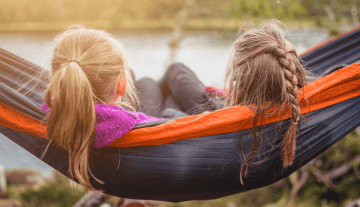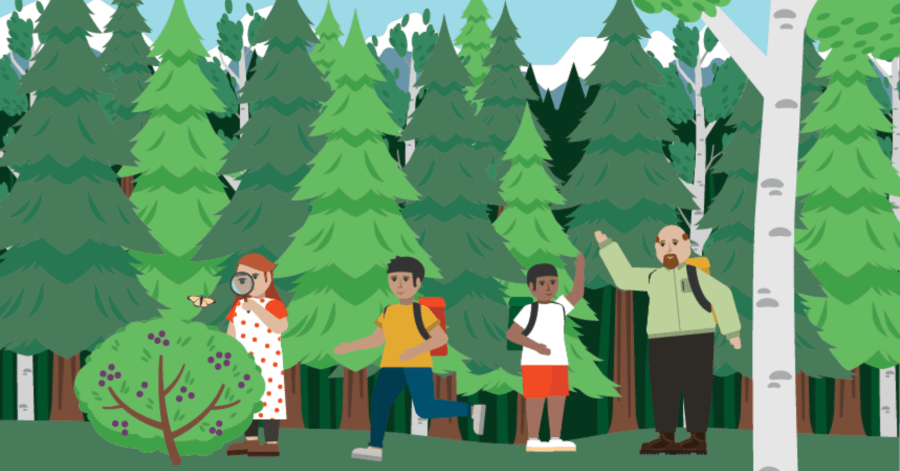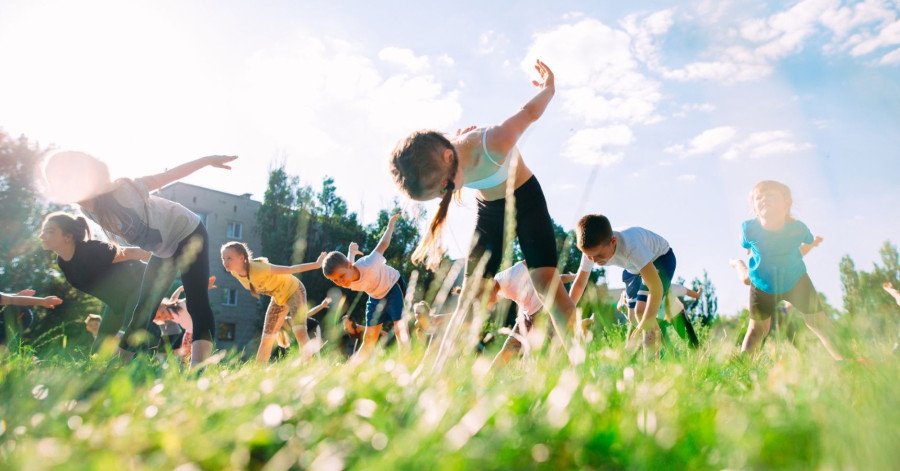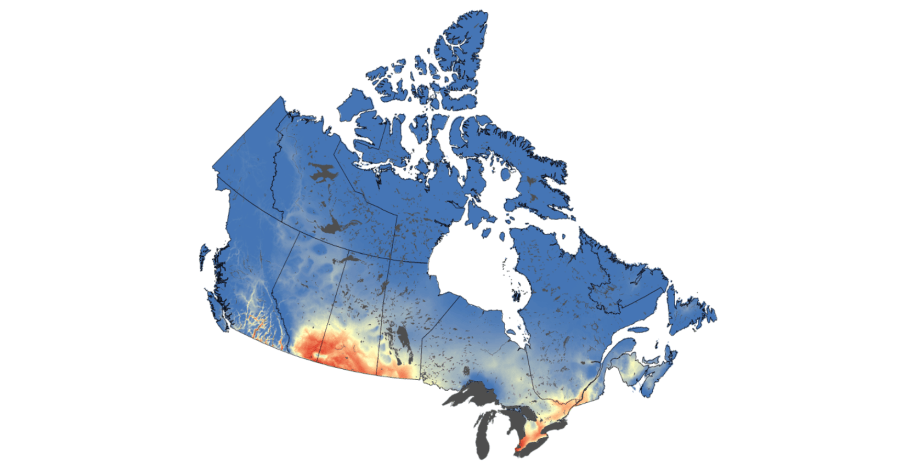Mindfulness and positive change
Students explore climate change and the emotions it brings, connect with nature to build eco-hope, and practice mindfulness while learning how clean energy shapes a positive future.
- Grades 4-7
- 3 activities
- 3.3 hours

Big idea
Daily participation in physical activity at moderate to vigorous intensity levels benefits all aspects of our well-being.
Learning objectives
- Demonstrate understanding of climate anxiety and eco-hope
- Understand and take action on climate issues to reduce anxiety about the future
- Experience the benefits of breathing, yoga and meditation to provide a positive attitude and foster hope
Activities

Nature art for eco-hope
Connect with nature to discover ways to help our planet and take action on climate change.

Mindfulness for battling climate anxiety
Breathe and practice positive thoughts for eco-hope
BC curriculum fit
See how this unit maps to the B.C. Curriculum requirements for Physical health and education 4-7 and Arts Education 4-7.
Thinking
- Critical and reflective thinking: analyzing and critiquing, questioning and investigating, reflecting and assessing.
Personal and Social
- Personal awareness and responsibility: self regulating and well being
- Social awareness and responsibility: contributing to community and caring for the environment
Physical health and education 4
Big ideas
- Daily participation in physical activity at moderate to vigorous intensity levels benefits all aspects of our well-being.
- Personal choices and social and environmental factors influence our health and well-being.
Content
- proper technique for fundamental movement skills, including non-locomotor, locomotor and manipulative skills
- benefits of physical activity and exercise
Curricular Competency
- Physical literacy: Develop and apply a variety of fundamental movement skills in a variety of physical activities and environments
- Healthy and active living: Identify and describe factors that influence healthy choices
- Mental well-being: Describe and assess strategies for promoting mental well-being and describe factors that positively influence mental well-being and self-identity
Physical health and education 5
Big ideas
- Daily physical activity enables us to practice skillful movement and helps us develop personal fitness.
- Personal choices and social and environmental factors influence our health and well-being.
Content
- proper technique for fundamental movement skills, including non-locomotor, locomotor and manipulative skills
- benefits of physical activity and exercise
Curricular Competency
- Physical literacy: Develop and apply a variety of fundamental movement skills in a variety of physical activities and environments
- Healthy and active living: Identify and apply strategies for pursuing personal healthy-living goals
- Mental well-being: Describe and assess strategies for promoting mental well-being and describe factors that positively influence mental well-being and self-identity
Physical health and education 6
Big ideas
- Daily physical activity enables us to practice skillful movement and helps us develop personal fitness.
- Healthy choices influence our physical, emotional, and mental well-being health.
Content
- proper technique for fundamental movement skills, including non-locomotor, locomotor and manipulative skills
Curricular Competency
- Physical literacy: Develop, refine and apply fundamental movement skills in a variety of physical activities and environments
- Healthy and active living: Identify, apply and reflect on strategies used to pursue personal healthy-living goals
- Mental well-being: Describe and assess strategies for promoting mental well-being, for self and others
Physical health and education 7
Big ideas
- Daily participation in different types of physical activity influences our physical literacy and personal health and fitness goals.
- Healthy choices influence our physical, emotional, and mental well-being health.
Content
- proper technique for fundamental movement skills, including non-locomotor, locomotor and manipulative skills
- effects of different types of physical activity on the body
Curricular Competency
- Physical literacy: Develop, refine and apply fundamental movement skills in a variety of physical activities and environments
- Healthy and active living: Identify and apply strategies to pursue personal healthy-living goals
- Mental well-being: Describe and assess strategies for promoting mental well-being, for self and others
Arts Education 4
Big idea
- Exploring works of art exposes us to diverse values, knowledge, and perspectives.
Content
- Symbolism and metaphor create and represent meaning
- personal and collective responsibility associated with creating, experiencing, or presenting in a safe learning environment
Curricular Competency
- Exploring and creating: Explore identity, place, culture, and belonging through arts experiences
- Communicating and documenting: Express, feelings, ideas, and experiences in creative ways
Arts Education 5
Big idea
- Works of art influence and are influenced by the world around us.
Content
- Symbolism and metaphor to explore ideas and perspective
- personal and collective responsibility associated with creating, experiencing, or presenting in a safe learning environment
Curricular Competency
- Exploring and creating: Explore connections to identity, place, culture, and belonging through creative expression
- Communicating and documenting: Express, feelings, ideas, and experiences through the arts
Arts Education 6
Big idea
- Experiencing art is a means to develop empathy for others’ perspectives and experiences.
Content
- Symbolism and metaphor to explore ideas and perspective
- personal and collective responsibility associated with creating, experiencing, or presenting in a safe learning environment
Curricular Competency
- Exploring and creating: Explore relationships between identity, place, culture, society and belonging through the arts
- Communicating and documenting: Express, feelings, ideas, and experiences through the arts
Arts Education 7
Big idea
- Engaging in the arts develops people’s ability to understand and express complex ideas.
Content
- Symbolism and metaphor to explore ideas and perspective
- personal and collective responsibility associated with creating, experiencing, or presenting in a safe learning environment
Curricular Competency
- Exploring and creating: Explore relationships between identity, place, culture, society and belonging through the arts
Communicating and documenting: Express, feelings, ideas, and experiences through the arts
Assessments
- Assess students’ understanding of climate anxiety and eco-hope.
- Assess students’ creativity and connection to nature with drawing and immersion.
- Assess students’ social awareness and responsibility in mitigating climate change and taking care of the environment.
- Assess students' understanding of breathing, yoga, and meditation as methods for self-regulation and future preparedness.
Background info
Understanding climate anxiety
Excerpt from the Mental Health and Climate Change Alliance
“Climate change isn’t just an environmental issue—it’s also an emotional one for many young people. Children and teens today are acutely aware of climate threats, and this awareness often comes with intense feelings. In a recent international survey of 10,000 youth (ages 16–25), nearly 60% said they feel “very” or “extremely” worried about climate change, with almost half saying these worries negatively affect their daily lives. Canadian youth echo these concerns: in one national study, 73% of young Canadians said the future feels “frightening” due to climate change, and nearly half believed “humanity is doomed”. Over three-quarters reported that climate change impacts their overall mental health, and 4 in 10 said their climate-related feelings have a negative effect on their daily life. Clearly, climate change is no distant abstraction for our kids – it’s a real source of stress, anxiety, and even despair in their lives”.
Building eco-hope
Strategies to build eco-hope include connecting with nature and your community, focusing on controllable actions and small wins, channeling emotions into positive action, and educating yourself and others about environmental issues. Engage with inspiring environmental campaigns, join local groups, practice self-compassion, and limit overwhelming climate news to avoid burnout.
BC Hydro takes action on climate change
BC Hydro is taking action on climate change by working within the provincial CleanBC plan to increase the supply of clean electricity, improving energy efficiency, and reducing the carbon impact of its own operations. Key initiatives include adding renewable energy sources through calls for power, investing significantly in energy efficiency programs for customers, and reducing greenhouse gas (GHG) emissions from its own buildings, fleet, and equipment.
Breathing techniques
Go to Breathing techniques to explore a variety of breathing exercises.


